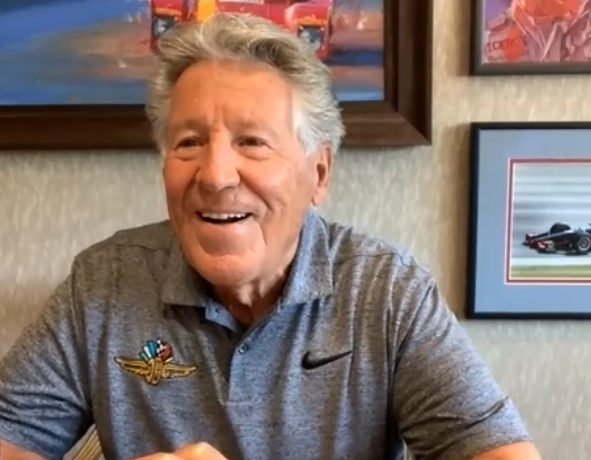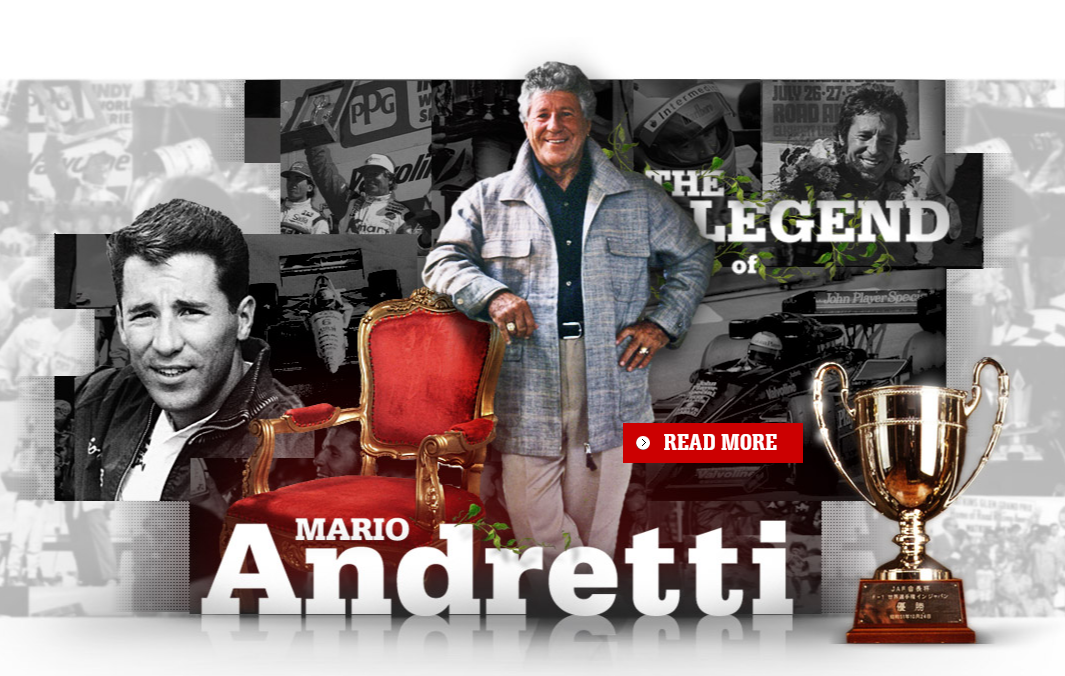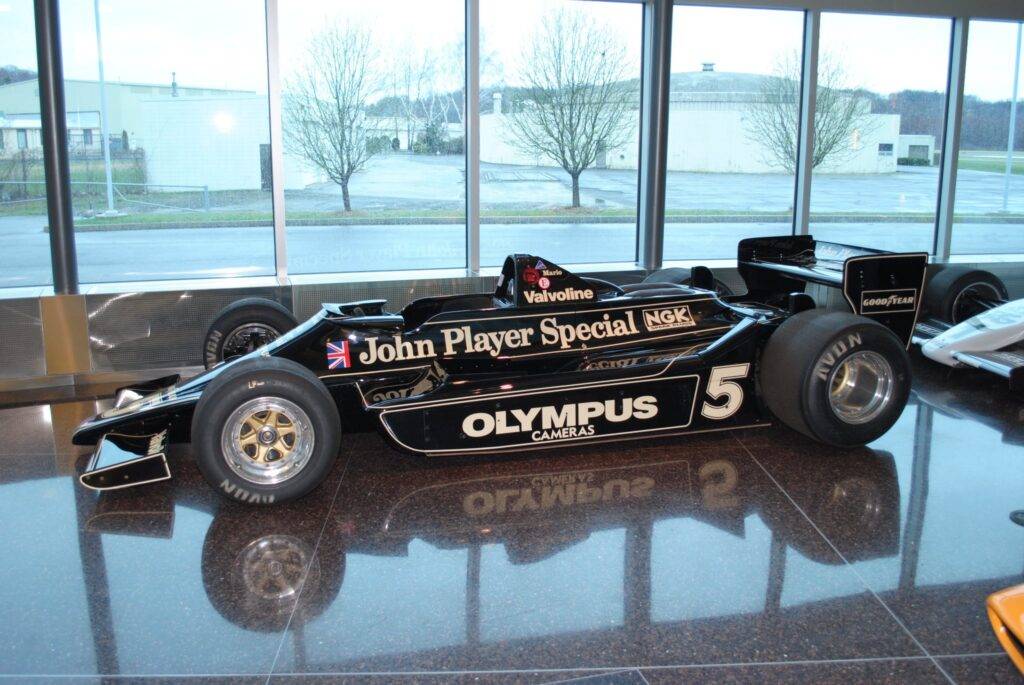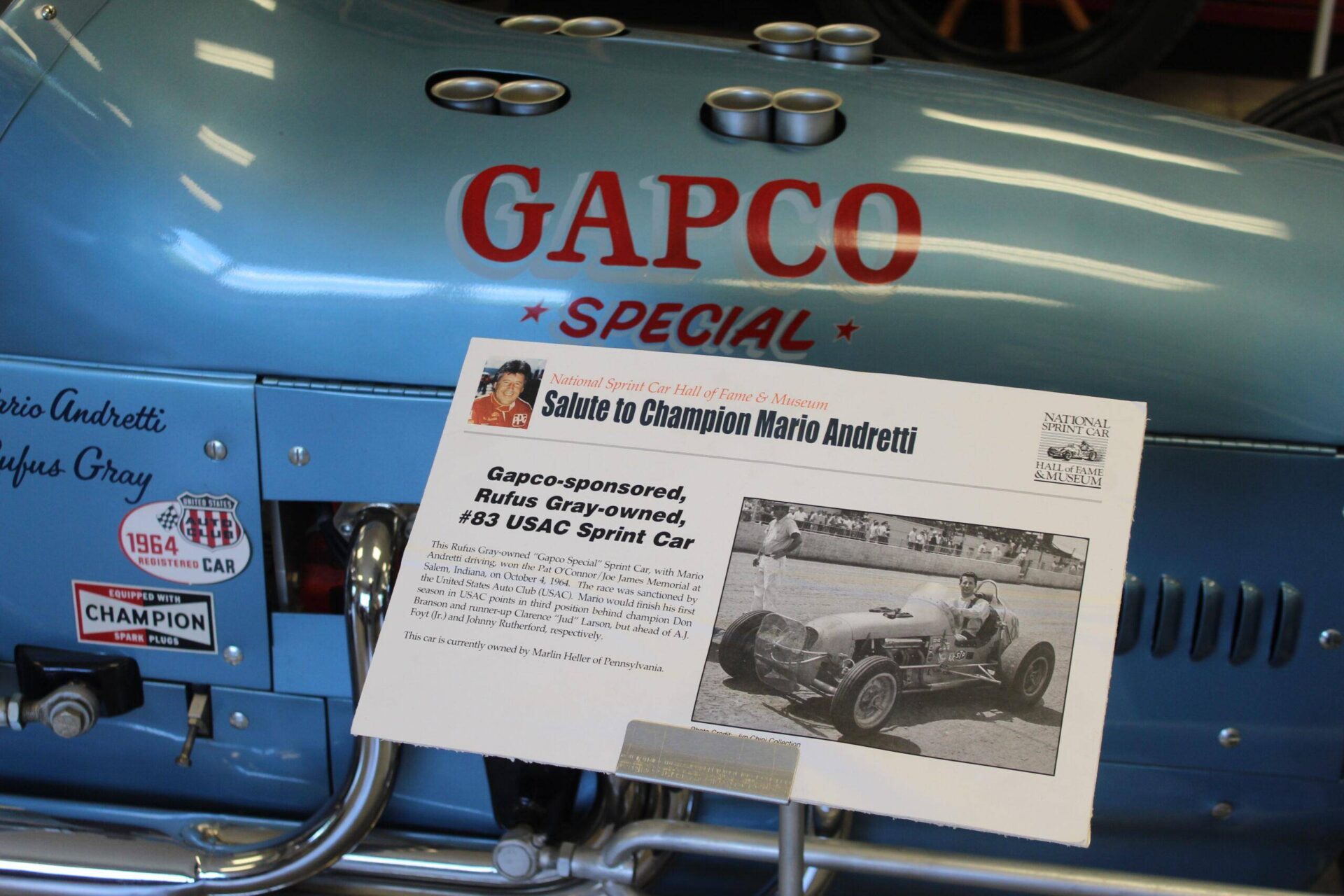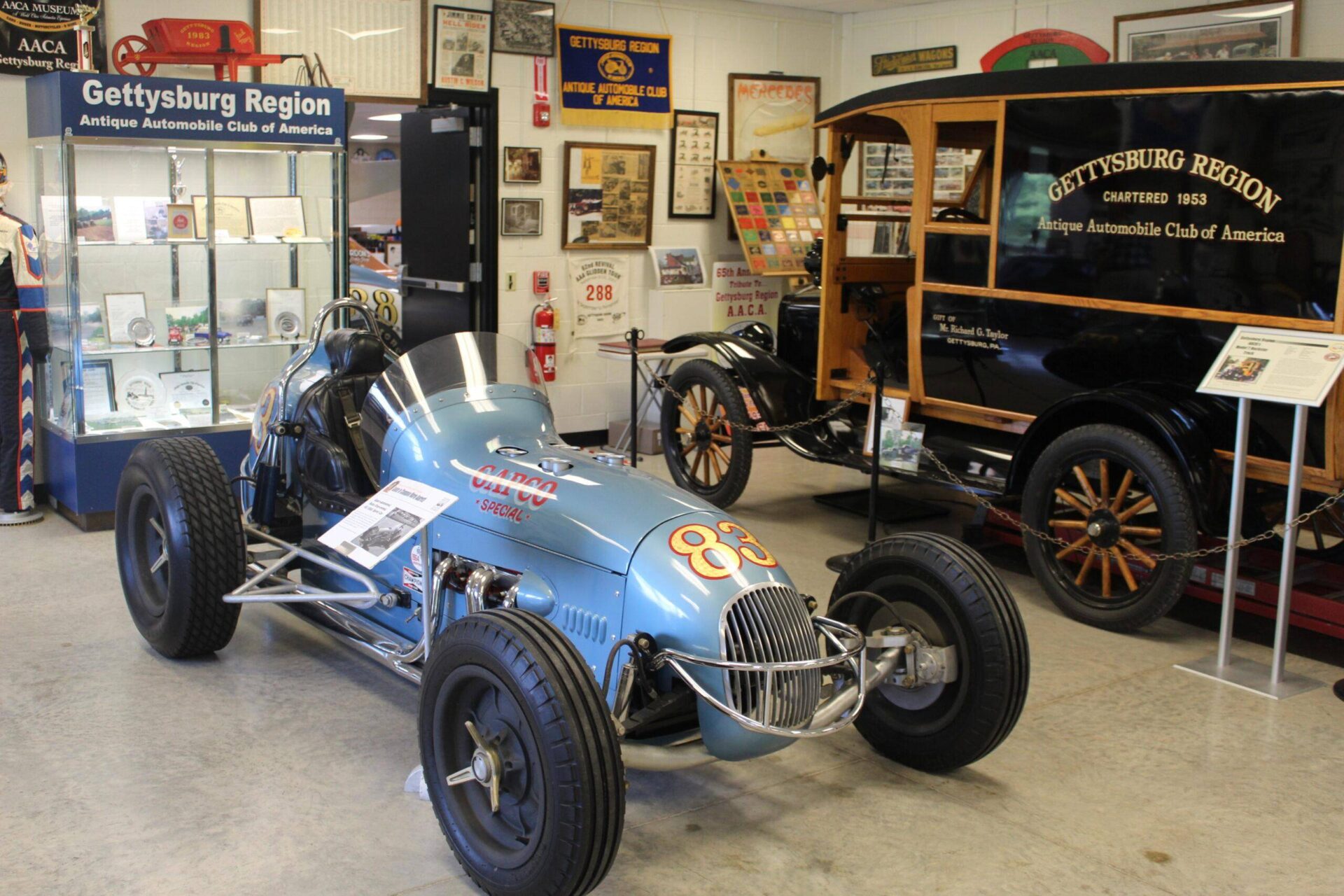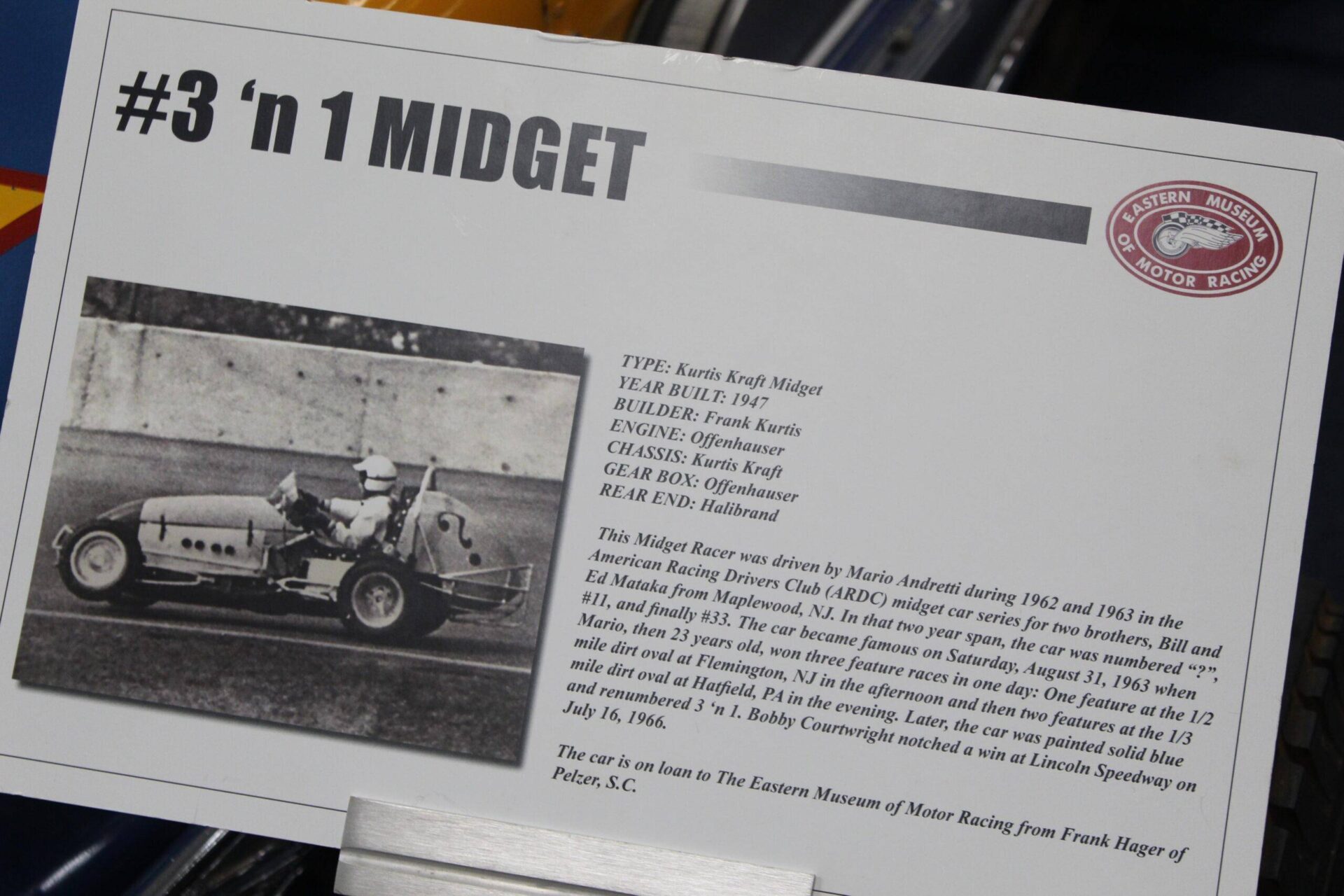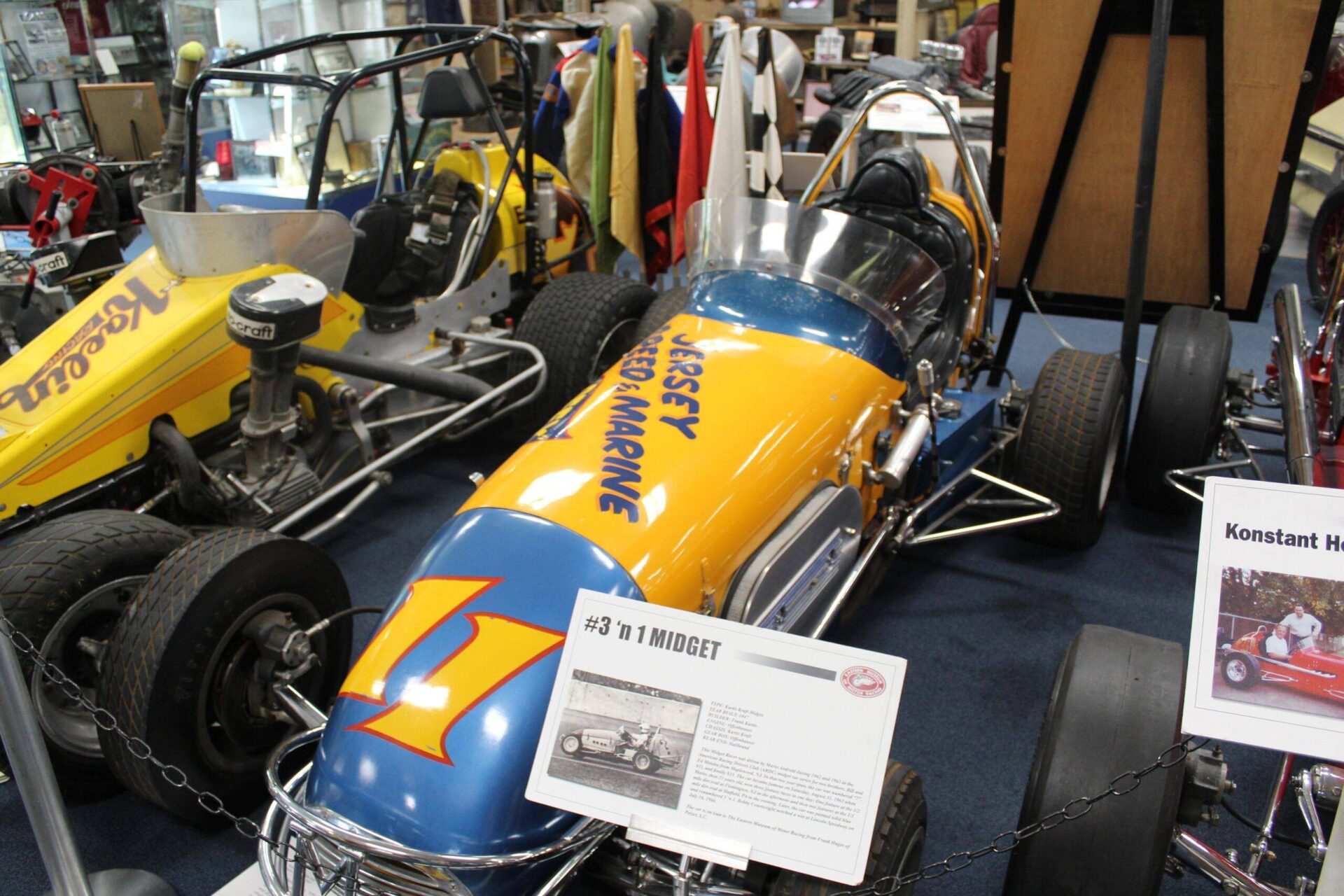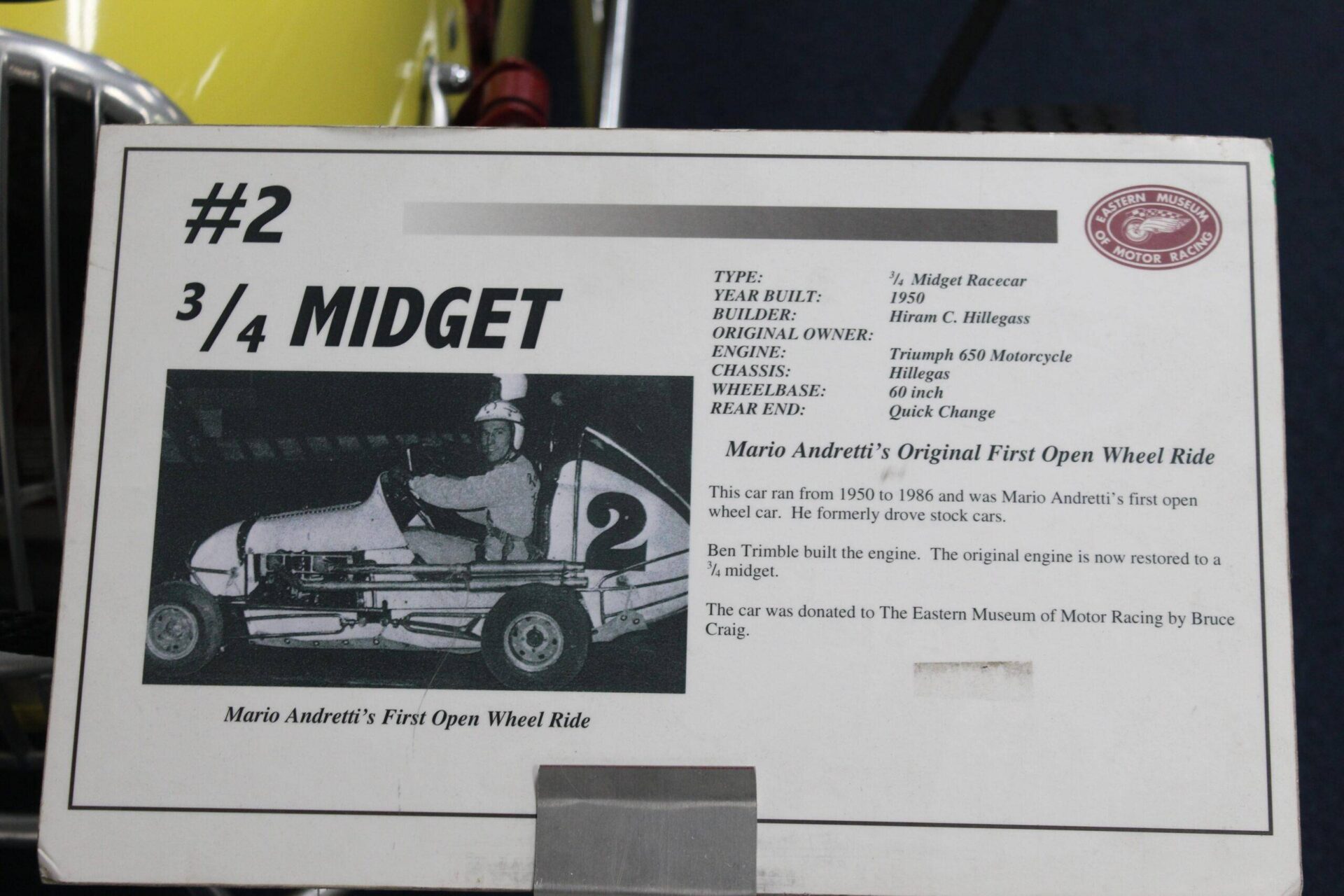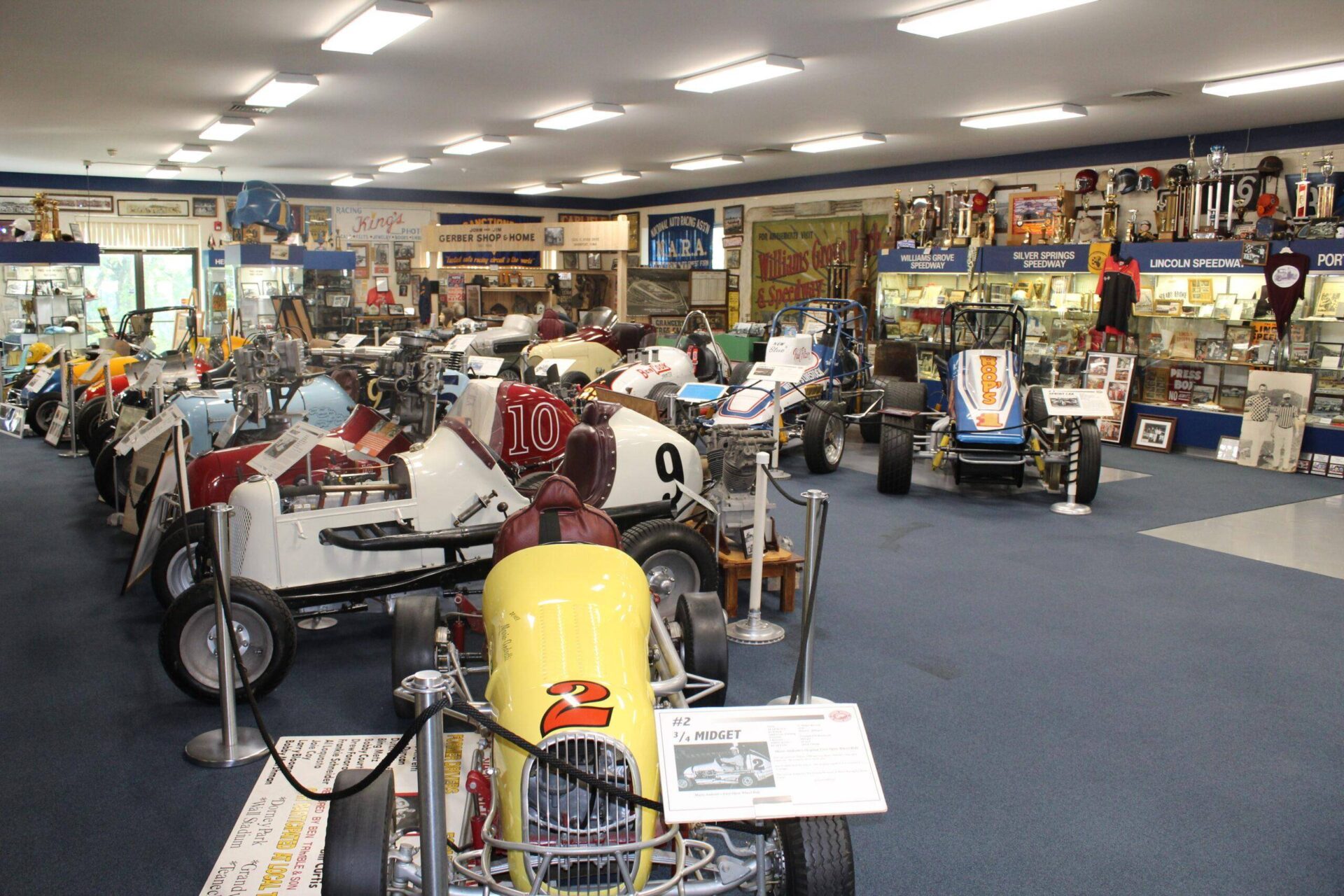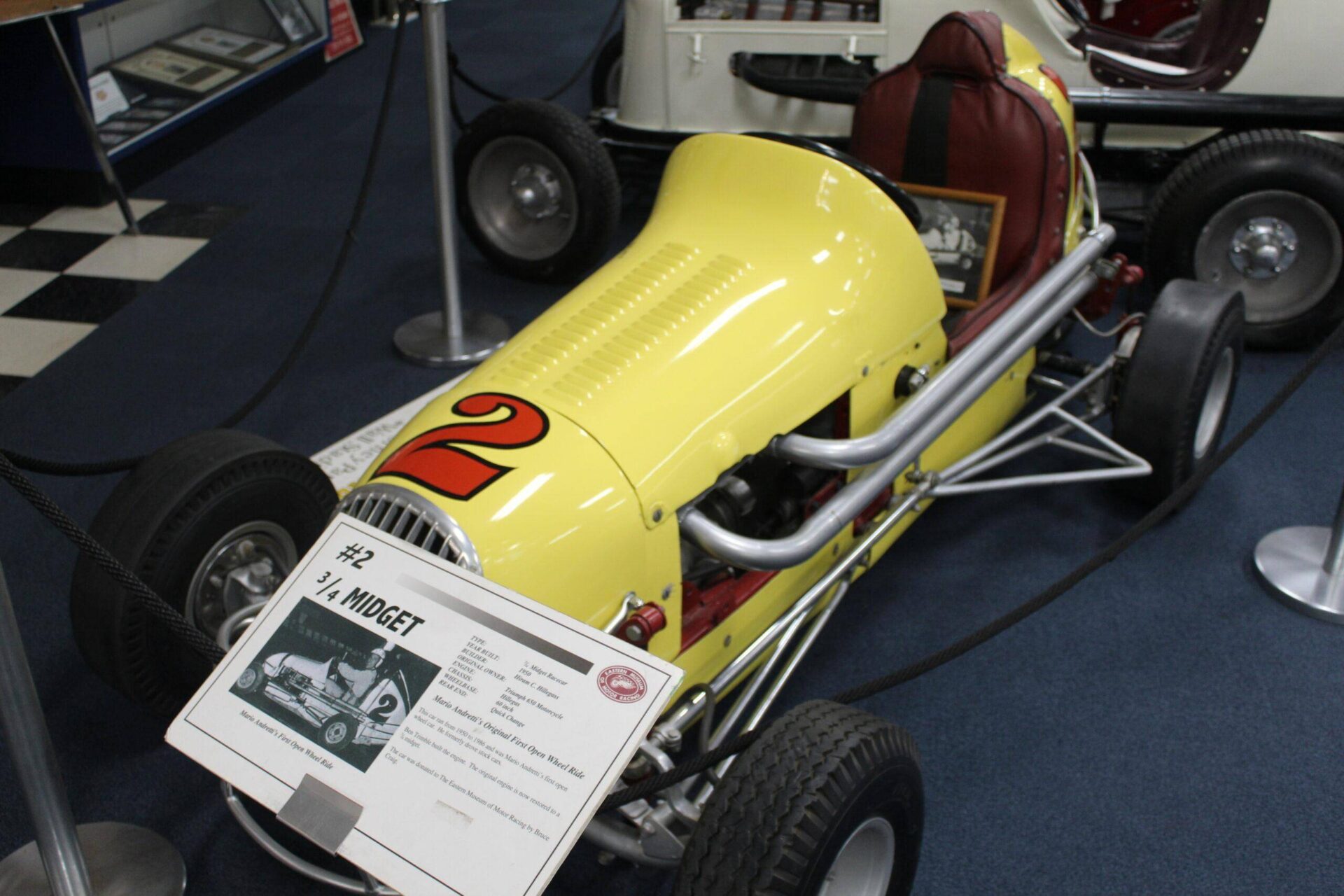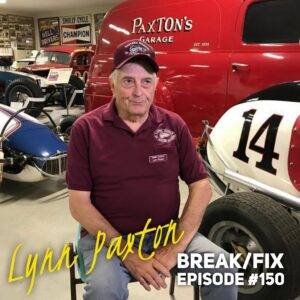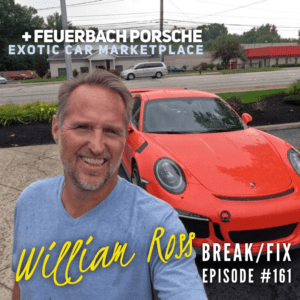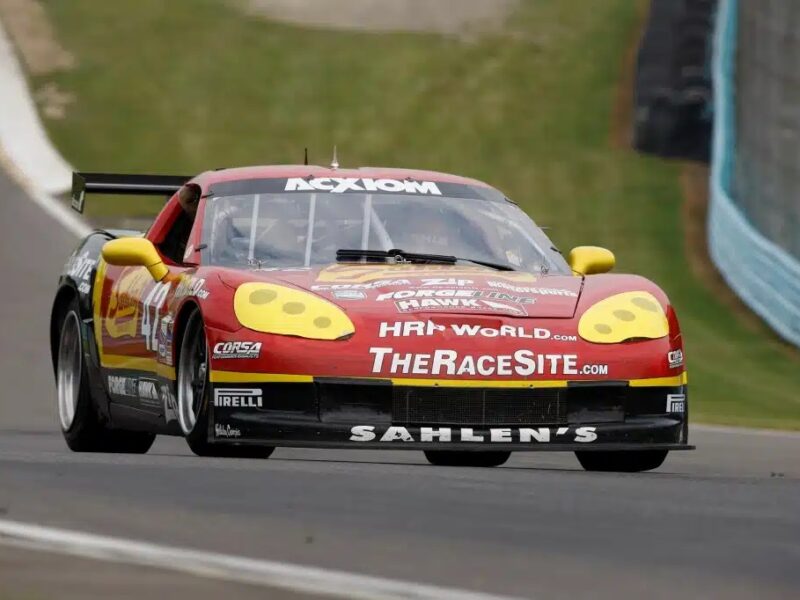Our guest is a racing icon, considered by many to be the greatest race car driver in the history of the sport. Born in Italy, emigrated to the United States at 15, and began racing stock cars in Pennsylvania at 19 which was the start of an illustrious career. He won races in sports cars, sprint cars and stock cars – on ovals, road courses, drag strips, on dirt and on pavement.
His achievements became legendary: The world watched as he won the Daytona 500, the Indy 500 and ultimately the Formula One World Championship, an unprecedented trifecta. Mario Andretti took the checkered flag 111 times during his career – a career that stretched five decades and across six continents.
Notes
- You raced for five decades.Like we mentioned in the intro 111 wins, does that count the 23 before you turned 21 and were legally allowed to race?
- Staying on top of new technology certainly played a part in your longevity. When you started racing, they didn’t even have radios in the race cars. The technology evolution that you have lived through has been incredible…You recently drove a modern F1 car at COTA, what was that like?
- We’ve heard that one of the drivers that inspired you to race was Alberto Ascari (from Ferrari), did that give you a desire to pursue F1.
- You raced at Pikes Peak? (With Bobby Unser).
- What possessed you to approach Colin Chapman (after Jim Clark won the 1965 Indy 500) and ask about a ride?
- You recently reunited with Jacky Ickx. You and Jacky were teammates in 11 grand prix races for Ferrari, six in 1971 and five in 1972. In the same timeframe, you ran 9 long distance races, had six poles, 4 wins and one second place finish.
- We talked in the beginning about the technology changes in racing, but Safety also changed during the late 60s and early 70s in both F1 and LeMans. When you raced in prototypes at LeMans with Jacky Ickx; a couple years after his infamous boycotting of the LeMans start – feelings on that?
- Thoughts on the 100th Anniversary of LeMans? Are you going? Are you participating in it in some way?
and much, much more!
Transcript
[00:00:00] Hello and welcome to the Grand Touring Motor Sports Podcast Break Fix, where we’re always fixing the break into something motor sports related.
Our guest is a racing icon considered by many to be the greatest race driver in the history of the sport. Born in Italy, emigrated to United States. At 15, he began racing stock cars in Pennsylvania at 19, which was the start of an illustrious career. He won races and sports cars, sprint cars, and stock cars on ovals road courses, drag strips on dirt and pavement.
His achievements have become legendary. The world watched as he won the Daytona 500, the Indie 500, and ultimately the Formula One Championship. An unprecedented trifecta. Mario Andretti took the checkered flag 111 times during his career, a career that has stretched five decades and across six continents.
I am joined by William Ross from the Exotic Car Marketplace in welcoming the one and only Mario Andretti to break fix. [00:01:00] Thank you. Thank you very much. Appreciate you taking the time to join us, Mario. Really appreciate it. Well, it’s my pleasure. My pleasure. In Eric’s intro, he mentions the hundred 11 wins.
Does that include the 23 that started when you were underage? No, it doesn’t because it’s almost impossible to verify those because of the times. It was not a, um, a sanction series. It’s a local. You know, a race within 150 miles, you know, different tracks, Western Pennsylvania and New Jersey. But, uh, it was not sanctioned, so they cannot verify it.
We started when I was 21, started with the three quarter midgets, which was, uh, sanctioned by American three Quarter Racing Association, U R C and A R D C in, in 1959 and 1960. I won a lot of races. You know, the way, as much as I can remember is 23 races. I’ll take your word for it. We’ll add it to the tally.
It says, you can ask some of my [00:02:00] friends, they’re verified. I was watching the year before when Zach Brown offered you to drive his McLaren at Coda. I always remember that day, cuz you’re walking next to him, you kind of said it halfheartedly. And he said, sure. Look on your face with shock, like really? And then they set it up.
So I was curious, how was it driving that car? And obviously it’d been a long time since you’re in something so technologically advanced like that. Well actually, uh, it was pretty much everything I expected, if you will, because, uh, it’s not that I’ve been totally out of it and Indy car and every aspect has a lot of the same commands and so forth.
And I’ve done some testing for my son on high speed and then I was playing around with it. I’m pretty current technically. It was really a pleasure. I just wish that I would’ve had more time to really get the cockpit property, the adjustments. It was impossible to adjust the pedal platform and the steering.
There was no adjustment at all. So for me to reach a pedals, because, uh, I’m not six [00:03:00] foot two, so they had to bring me up so far forward that the steering was right in my chest. So I could not really get the feel that I wanted to be able to thrash the car like I wanted to. I got what I expected and I’m grateful that he made that available for me.
Of course, Zach Brown is a good man. He is a great friend. And next time I’m gonna ask for a full day of testing so we can set a record. And a seat fitting. Fitting, yeah. I’m must say the padding was very soft. You know, it was soft foam, rubber. I felt like it was in a jelly bowl one time down the straightaway.
You know, my device. The back of it got stuck on my headrest and I was looking up at the sky about an hour. I said, oh my goodness. Well, anyway, other than that was fun. I will say from the outside, all of those things that you described, none of us could tell, and I will say this, watching you drive a modern formula [00:04:00] one car at Cota lap after lap, despite everything you just said, it looked like you were going faster and faster and faster.
Your lines were perfect, your apexes were on point. You sat back and you go. I’m watching a master. Just learn from this, watch this in slow motion, every little inch of the track. So hearing it from the other side is hilarious. But from those of us watching, it was perfection. Well, you’re very kind. Just wait until I get the seat fitting.
Obviously with what’s going on f now, the down force and everything, what’s going on with the ground effects, but I always found was interesting and you don’t hear much about it, you were really integral in regards to creating the ground effects, working with the engineers at Lotus, and if memory serves me, I know you’re saying how when you’re going around corners getting closer to the ground, it was creating that effect.
It popped in your head about the marches you drove. In regards to the angle of sidepods net, so you kinda were integral in creating the ground effects and helping get these, uh, perfected. What happened is in, uh, 97, the March 7 0 1, it was at a elli [00:05:00] effort in Formula One, and the car had sidepods. But the Sidepods was primarily cosmetic, but they were shape of wing profile.
We were testing in South Africa, which is altitude, and I’m looking at the silhouette of the car and I felt maybe we should take those off because I thought there was additional frontal area. And so we did, and all of a sudden the car started flying the front end. So basically I needed to compensate for the balance of the rear wing.
I needed more front wing, which that created actually more frontal area. Okay. So we bolted the sidepods back on, which meant they gave us some down force. Some forward center of pressure. Mm-hmm. At the end of 76 with Lotus, with the Colin and the engineers at the end of the season, you know, we all caucusing about, talking about, okay, what is a driver?
What would you like? You know? And I said, well, I said, as a driver, I would love to [00:06:00] have down force without penalty of drag, you know? Yeah. And nobody left. The bottom line is, I gave that example. And I said that nobody discussed that, ever. That I know. I said, but we tried it. We did take those off. So why don’t you construct on a new car, get a longer profile?
Because if you look at that March 7 0 1, those wind profiles were very short, and I said, mm-hmm. Why don’t you take advantage of the entire wheel base, you know, and then of course you put the fences on, you know, so we’ll direct the air properly because there were no fences on those, you know, the fences were made.
End plates. Mm-hmm. Anyway, so that’s how the load of 78 was born in 1977. Immediately we got definitely ground effect out of it, but we were still searching. We were not really on it, if you will. The other part is that we found out, which is very important. All of the wind tunnel testing was done was static wind [00:07:00] tunnel.
They were getting some numbers that didn’t really coincide very much with what we were feeling. You know, on a track we’re testing in Hoen I Germany, Porsche Curve that connects a two main straightaways is kind of a long right-hander. And I remember just in the middle of the righthander when you get the, you know, the must roll in the car.
That means we were closing the side plate to the ground. All of a sudden I was getting an enormous amount of down force and the car fell good and I was really flying through that corner. And I came in and I said, you know, I said, there’s something about closing the gap here. Okay, how do we do that? So Colin sent, uh, one of the mechanics into town to get some plastic sheets, pop rdo on to drag on the ground, and I went out.
All of a sudden it was a whole new deal. The car really fell going flying, but two laps later you wear ’em out and then you’re back. Where he started the next race, he had like bristles, like uh, broom bristles, you [00:08:00] know? Yeah. They were not that affected, but they were at least. Consistent after that, the so-called movable skirts were born, he designed that, which obviously that’s when the situation was much more consistent and then also more, most effective.
So you could see there was a, we were searching throughout the season, started out on the one idea and it turned out to be something else. And then, and then what was important was that Colin Chapman, they were the first ones to develop. A wind tunnel with a belt, which would mean a moving road. And of course the wheels had to be turning.
You realize how much the wheels were affecting the flow into the tunnels. And so a lot of, you know what I mean? Then, then all of a sudden it’s a whole new deal, how you’re designed to direct the air in that direction and all that. So, but again, you were just learning and then, then you could start putting the pieces together.
I, uh, okay, this is a whole new world now. Then of course everybody else, uh, you know, obviously [00:09:00] pursued the same thing and then great engineers, all the other teams and they just started perfecting in the wrong way. But, uh, we definitely are the ones that, you know, that Lord us, that brought this about, you know, this idea.
It’s great how Connell was willing to push the envelope like that and have those ideas. You know, he was brilliant in that aspect. In regards to new techniques, new things, trying stuff and building cars like that. Yeah. It was also interesting that, you know, you talk about purposing and all that, you know, we actually started with putting a name to that bouncing that the car gets, the more down force that you got.
Then we started getting that because the car would be at high speed, pushed down and bounced up. As soon as you hit the travel of the dampers and get on the bump rubbers, then it bounces right back up. Then you get all of this. Well, obviously I saw when, you know, they went back to the tunnels in Formula One.
I saw that they, they were dealing with this purposing situation. It was very familiar, as you can imagine for us. Did you guys [00:10:00] have it as bad as they seem to have it in the beginning last year? Well, we did, but each design will produce more frequent. Or less, and also depends how stiff your suspension is at the time.
But purpose, purpose is very annoying and disturbing and, and obviously physically it’s a real problem for the driver, no question. Oh yeah, we’re on you quite considerably. Yeah. I kind of wanna jump into Italy, I believe you said you were 14 when you went to Mazda for the first time to watch your first F1 race.
14. Yes. That was the year before we came to the States. Yes. Was your favorite driver at that time, or always as Ben as one of your favorite drivers? Yeah, of course. You know, Italy was very prominent in Formula One, as you can imagine. The fifties with Ferrari, you know, Maserati especially. And then of course the beginning Formula One.
Winning the first official world championship. And Alberto Scotty was, at the time, was, uh, first, uh, time World champion. Mm-hmm. This Farina was, I’m not clear on that, but, uh, nevertheless, [00:11:00] you know, I was just a teenager and Al Scotti was the guy to be able to, uh, witness him firsthand, Monza, you know, it was a huge, huge thing for me and my brother, Aldo, my twin brother.
But honestly that’s when my, uh, the dream of becoming race driver was cemented in my head, you know? No question. When you got over here though, 15, what were you working to get to, because you obviously didn’t start racing until you were about 19. What were you doing in that interim here, in those four years?
Were you just trying to get everything together to start, go racing or. Were you doing some other things at that age? I was going to school. You know, Al and I, we were going to school and then, uh, we used to alternate in the evening, uh, working at, we call him my uncle. He was, he was married to my second cousin.
He had a Sunoco gas station at the end of town. And that was a great way to be able, you know, to mingle with people and learn the language. Because, uh, in school in Italy, we had three years of English. But, uh, you know, it was not practical. I mean, [00:12:00] I couldn’t even ask for postcard in English, you know, when, when we came here.
But when you have a more knowledge of the grammar, you know, it’s easier to learn the language. And, and in school we. I think we did quite well, but it was, the objective was to really, we arrived in the States here in June, of course, start school in September, but I vowed, I said, bye Christmas. I wanna be able to communicate in English.
And uh, and I think, uh, we achieved that Aldon I, which was very useful. But going back to your question, when we arrived here on a Thursday, we were hanging out at my uncle’s house at the end of Nazareth, at the end of town. And Sunday night we see the bright lights on the background and then all of a sudden a big explosion of engines.
And that’s when we discovered modified stock cars. And that’s when the idea started. I said, uh, because you know, you had a dream. Okay. How do you put a dream into reality? You know, we didn’t know much about racing in the states except [00:13:00] after seeing a movie, uh, to please a lady in Italy, that’s another one that gave us some idea that what was going on here, but, uh, it was dirt racing, was something that I said, oh, I don’t know.
It was very foreign. After seeing a Formula One race and Moza, then going to the fairground and seeing the stock, you know, the one good thing it looked doable, didn’t look as sophisticated. That’s what, two years after we arrived here in 1957, we got to know somebody. You know, always you talk racing and as, and always say, you know, I tell the same story I said there, there was a geek there, a guy that knew everything.
Charlie, Mitch and he is the one that was giving some ideas as uh, what, how to go about it. And, uh, we could not afford to go modified race by, they had a category sportsman. And uh, that’s what we pursued. And we did the right thing because the Hudson cars were very popular in NASCAR on the dirt tracks.
They were winning pretty much winning muscular races. At the [00:14:00] time. So, uh, we pursued that. We bought some information from a Marshall T team factory folded. They went out ERA at the time officially. So we got suspension setups, we got, uh, all that, which was, uh, pivotal was uh, amazing, uh, useful. That was for us.
And then, uh, we found out that the factory were sold all the racing engines to, uh, their Whitney company in Chicago that they were selling for, like power plants or something. So we bought one of the racing engines there and you know, when we put that thing together, you know, if we thought that, okay, we start racing at 21, but the car was ready, we were 19, I said, time to go.
And, uh, we had a friend of ours that, uh, fudged a, uh, well actually the. Editor of the local paper fudge the birthdates on our license, driver’s license and telling everybody that we used to race in Italy and all that. So it was a bit of a fib there, but for sure. But anyway, so that’s when it started 1959.
And although. [00:15:00] Aldo, by the way, one car to drivers, Aldo, one to toss. He won the heat and the feature in the very first race. Yeah, your brother was a heck of a driver too. You know, we have some newspaper clippings to back that up, by the way, not just the dream. You peaked my interest when you started talking about dirt, but not in the same way.
I grew up during what’s known as the killer B or group B era, watching drivers like Michelle Muon and Walter Rural and Cola driving rally cars, and that’s what I wanted to be. I wanted to be a W R C guy. Yeah. But as we look through your portfolio, you’ve done so many different disciplines of racing, which is amazing.
And in that, Are attempts at Pike’s Peak and a win at Pike’s Peak, and you hold it. Similar title to Bobby Unser who won Pike’s Peak in the same year as winning indie, and that was back in 1969. So what drove you to go to Colorado Springs? What about that Pike’s Peak experience? Well, I was Bobby Young.
He’s the one, you know, he, you know, we were good pals. [00:16:00] He’s the one that talked me into it. As a matter of fact, the very first one, I only drove there three times, three years, one and a third, and I figured I’ll never go back. I think I was gonna kill myself, but, uh, I took so many risks on that third year, but, The first year I drove and the deal was with him that I’ll drive if he only drives a stock car class.
You know, so I don’t have to compete against him cause there’s no way I could’ve beaten him. Uh, there he knew that place so well. And that’s what the whole thing is. You needed to know 183 corners. There’s no way. An end point is you miss one, a couple of ’em. And they used to say that a bird will build an nest up your butt before you hit the bottom.
That’s how far he had, so you had to respect the place. There was not a guard rail, you know this. I mean, they were just going, there was no guard rails at all. Nowhere. And obviously Bobby went on to run many times more At Pike’s Peak, he set the record in the Audi Sport Quattro S one, which was [00:17:00] later taken away by Puja and things like that in the eighties.
What do you think about now, Pike’s Peak has been paved all the way to the summit. Is it really still the same race to the clouds? No way. No way. I mean, you talk about rallying, you know, I, uh, that’s why I said that at least I have a taste of that. I could say that I technically did rallying, you know, because that’s what it was all about.
You know, the dirt racing left. Right up and down, you know, and, and breaking, accelerating. Yeah. That was unique in itself. No question. And now being paved, I mean, now it’s, uh, it’s just another hill climb. As we transition the conversation here, both William and I wanna dive a little bit more. Into Formula One, but we also wanna talk about your time at Lamont because Lamont is coming up on its hundredth anniversary here very soon.
You talked about starting in Dirt and stock car and, and we’ve talked about Pikes Peak, but I’ve heard the story that you sort of walked up to Colin Chapman after Jim Clark won the 65 8500 and you, and you were [00:18:00] asking him about a ride. But is that really how it played out and where did you find the motivation to just.
You know, knock on his door and say, Hey, Mr. Chapman, I, I wanna come drive for you. Well, you know, in 65, uh, at Indianapolis, uh, it’s one race where you have the luxury of spending a lot of time, much more even was one week longer than now even. And so you get to know people, you know, every day. And I, back of my head was always, somehow I wanna have the opportunity to do some Formula One in my career.
At the time, there was not much, uh, road racing on single Cedars. The way it worked out with Colin Chapman and, and Jim Clark. You know, I got to know him quite well for the period that we were there. So I finished her. So I got Rookie of the year, so I got some recognition, the end of the banquet, you know, which was traditional banquet, which goes on, uh, every year now.
Even, uh, the day after the race, we were saying our goodbyes. I said, Colin, I said, someday I would like to do Formula One. And he said, Mario, he says, whenever you think you’re [00:19:00] ready, you call me and I’ll have a car for you. You know, I hit Cloud nine at that point, you know, my objective then was to try to hone my skills into road racing, you know, as, as luck would have it.
There was just one road race in 1965 on that season, which was Indianapolis Raceway Park, which I won the only race that I won, even though I won a national championship that year. That’s the only race that I won. I got a lot of seconds and thirds and so forth. And the other one is when I was driving midgets, was driving the R D C mid.
There was one race, a lime rock on a road course. And I won that one. And there they even had Mark Donahue with one of John Cooper’s, you know, chassis was a rearrangement. They was constructed just for that race was brought in for just that race. And he led until the last lap. And I got him the last lap, cross the finish line.
And uh, so I thought it was PIO that day actually. Uh, it was, [00:20:00] you know, I road racing was something in, in. That, that was part of my objective right from the very beginning. I love my third track racing, but that was the way to get there. You know, the reason why I, I really tried to get the attention of four to be able to join the uh, Lamont program.
Because there was a big effort there to try to win Laman. Of course, Henry, for, that’s, that was his objective. And uh, there were no holes barred. So there was a lot of testing and development that I wanted to be part of. I made myself available for every test. You know, I befriended Bruce McLaren along the way.
Great guy in every way. Plus he was very technical driver and I was watching. His rotations breaking and accelerating through the snow corners and all that, all the technical part. He taught me a lot. Uh, Bruce taught me a lot actually. Uh, we wanted Seabring together with a new, new Mark four. So a lot of things were going in the right direction for me.
And [00:21:00] in 1968, I felt, you know what? It’s time. It’s time. It was, uh, two races left Italy and uh, the US. And I asked, uh, Colin, you know, if he is, if he would’ve ride, he absolutely, I will have a, he entered a third car for me for Italy and Kins Glen. It was a glitch there in Italy because I was gone for a national championship and it was a dirt race on Saturday of that weekend.
Who’s your hundred? So I was iza a week before testing and it went well. In fact, Chris Haman tested a Ferrari a few days before me, and, and at the end I was quicker than him and I couldn’t believe it, you know, just, uh, how well that Formula One suited me at that time. And so I was very encouraged, you know, after this, there was the problem.
Like I could only qualify on a Friday, you know, in those days. There was no specific qualifying period during the weekend and every lap that you turn in practice counted for [00:22:00] qualifying. Wow. So I had to get my qualifying and the first practice on Friday morning because I had a two 30 flight in the afternoon back to the states.
I brought Bobby with me. I got him a ride with the brm, Louis Stanley b rm, and so we could do some slip streaming. Cause Monza was very important to do that. And he and I did that. And at that point I was. Quickest. You know, we, but nobody was really trying very hard, but was quickest by a second and a half actually.
And so we left and ran. SJ actually ran second to Foyt and we went back the next day. We arrived at the track about an hour and a half before the race. My car was already on, the grid was seventh on the grid, but there was a protest. It was agreed that they were going to waive the 24 hour rule, which had been in place for a couple of years.
It was agreed, but you know, it still was a protest and I never really knew officially or protested. I think it was Ferrari and it was the only one that could have protested that. [00:23:00] Nevertheless, they would not let, let us start either Bobby or I. So the first actual official race was. Watkins Glen two weeks later, and I put the car in pole there, which surprised the hell out of myself, quite honestly.
But, you know, I felt like, okay, maybe, maybe I belong. It’s one of those moments where it’s so encouraging, you know, that, uh, it, it builds up your confidence that I haven’t been wasting my time type of thing, you know, like, uh, belong in, in, in this business. And, uh, great moments. These are important moments in, in my career, especially the fact, the difference between the two cars.
You say a Indy car. Heavy lot of power going out. Then you got this F1 card, super light, nimble. That’s impressive. Well, not only that, jumping to a prototype, doing the LeMans testing is completely different too. And so I think one of your key strengths, Mario, is that you had so many different racing disciplines under your belt by this point.
It made you a versatile driver. But also well-rounded maybe compared to other people that were coming [00:24:00] only from touring car or only from Open Wheel. You had this ability to basically morph into whatever you were driving and be successful behind the wheel of everything. Yeah. Merrick, I think it served me well in the sense that I could adapt.
From one animal to the other, I could adapt, uh, easier. And also because I really wanted it so bad, you know what I mean? I think there was a burning desire to get it done along with some of this wider experience. Like I used some of my experience on the dirt tracks, you know, dirt racing for the wet races because you always run a very different line through the corner.
It’s always searching for grip and a wet. And that’s what you do in the dirt, exactly what you do in the dirt. You could see that there’s something that seemed, that, you know, apples and oranges by comparison, you know, as far as the, the, you know, the type of car and circumstances, but lot of things mesh.
You know what I mean? You can put to good use what you learn, one for the other. You were talking about [00:25:00] the desire to win and to achieve and all that. And, and obviously along the way you made tons of friends, lifelong friends and teammates and et cetera. But I wonder, did you have any rivals or did just people consider Mario Andretti their rival?
You were the bar that they were trying to get to? You know, they’re different personalities that different teammates have, different personalities and, uh, I give you, for instance, like in, you know, even with Lotus and Formula One with, uh, Ronnie Peterson, he and I were really good friends outside of the track.
You know, we spent times together, you know, there were time when the family spent together, when he came to the States, you know, we’d go out and play around, you know, up at the lake and so forth. We’d have a beer together and try to kill each other on the racetrack. And then, then have a beer together, you know, that kind of a thing.
And Carlos Reitman, he wouldn’t even have dinner with me. You know, it just, he was very seclusive. It was that kind of a thing. He wanted to keep it that way. And other areas, [00:26:00] even in sports cars, you know, the teammate Jack Eeks and I got along, peachy, just, uh, you know, we understood each other and blah, blah, blah.
And there were others where, you know, you’re fighting, oh, I’m gonna qualify. I’m gonna qualify. You know, I had one or two of those. Again, it’s all about personalities, but you know, you try to, uh, to keep the peace as much as possible. It’s funny you say that. We had Lynn St. James on last year, and when I asked her that question, she said everyone was my rival.
Again, different perspectives on the same thing. We talk about rivals. Here’s the way I look at it. There’s always somebody better than you. Somewhere you’re learning, you know, the rivals. I mean, if it’s not a, a potent rival, you’re not gonna work as hard for some reason. So I always say that the rivalries are ultimately very healthy.
In my opinion. That’s the way it served for me. You know, there’s a premium as to who finished the second to you or who you finish second to very true. Yeah, that’s the way it works. [00:27:00] Speaking of Jackie Icks, you guys actually, uh, I wanna say reunited wherever, got together in Long Beach? Yes, we did. Yeah, actually I hadn’t seen him for a while.
Great way to catch up and sort of reminisce a little bit, but we, we had a great time together, obviously. That was a good period to be in a Ferrari and we won some good races together. What was it like switching from under Colin Chapman at Lotus and then working for I himself, Enzo? What was the culture like switching from the Brits to the Italians?
Uh, different culture for sure. And here again, that’s where you have to adapt the one. Good thing about Ferrari could speak the language. You know, some of the foreign drivers that, you know, they, everybody just even, you know, whether they’re German, whether whatever other nationality, you still learn the language.
But I could speak fluently and I could speak it with the mechanics, which was a good feeling, you know? And that was very special. And my relationship with Mr. Ferrari was, uh, also direct. I didn’t have to have a, uh, middle man between like Dr. [00:28:00] Gazi. Uh, For instance, uh, as of late. And you can imagine that just me having that relationship with him, you know, where I dreamt so much, you know, being a race driver because of Ferrari, really as a young lad.
So you could see how precious those times were for me. Yeah, especially winning your first F1 race in a Ferrari tab boot. Yeah. So many of the right things, you know, happening. My last experience in Formula One was a Ferrari, you know? And they do, you know, how do you design that? You cannot design, you know, someone upstairs.
Yeah, yeah. Somebody upstairs likes me. During the time period, especially when you were leaving Fedra in 1982, this was also where the Villa Pieroni rivalry was sort of coming to light. We’re starting to hear about that now. What was your take on that situation as you were sort of there on the scene? I was never in the middle of that.
All I know is that Villa Knew was loved by Anso Ferrari and he was delivering obviously, and it was a such [00:29:00] tragic time. Not, there was nothing I could talk about, you know, going back to Monza, uh, was Menti Tricity. Mm-hmm. You know, it was just sad. And you didn’t talk about it, obviously. Yeah. Trying circumstances.
You put aside everything else there was any controversy, you didn’t discuss it? Absolutely. That was something that whatever went on, went on with them. I had nothing to do with it. But the reason I bring it up leads back into the conversation about Jackie and in 1969, he stood his ground at LeMans and.
That I’m not partaking in this craziness. That is the Laman start and he walked out to his Porsche and he still ended up winning the race. At the end of it all, like we talked about in the beginning where William was talking about how the technology changed and you were in the new Formula One car recently, how has safety changed for the better?
Or maybe some things have stayed the same. How do you see the transition over the years as you’ve been involved in racing? Huge transition and everything [00:30:00] evolved. The safety aspect, as I say, certainly was not dealt with very vigorously, you know, in those years that we’re talking about. And it took someone like Jackie Eeks to stand firm and said, this is crazy.
Why are we doing this? Like I said, then all of a sudden I think the reasoning prevailed. I said, you know, Baba, we don’t do it anymore. So that was a step in the right direction for sure, because I experienced that in 66, and none of us actually really clipped the belt on, you know, until we were in Lamont.
30 miles an hour trying to click the belt on. So anyway, it was crazy. Uh, but the safety aspect is what I think saved the sport in my way of thinking. Going into modern times when the sport, you know, has become more commercial, as you could see with relying on, um, outside investment companies, penny millions of dollars to be.
Proud with being connected. They don’t wanna go to funerals, you know? So from our standpoint, it had to be something that we [00:31:00] had to lead. And actually all of us started with forming A G P D A in Formula one and demanding certain aspects of improving circuit safety. We started from the beginning, you know, from the bottom up.
I brought into Formula One, some, uh, you know, aircraft fueling aspect after I, the seabring, you know, they were dumping fuel on the funnel and got a bunch of fuel on me and when I went out and my whole right side of my leg blistered because, uh, you know, the heat and rubbing and the fuel I was all blistered down to, you know, a lot of things that.
And it took time. It took time. I’m one that obviously nowadays appreciates what today’s drivers are enjoying because I’ve seen and experienced back then, but in the same breath. Did that make a difference when we were in the car? Hell no. Did we hold back? Because of that, hell no. You know what I mean? You still went for it.
So that’s the way it is. But some of us are not here to [00:32:00] tell the story, you know, because of that. Unfortunately, it’s wonderful that today’s drivers, like I said, have the best chance ever to retire on their own terms. That’s a beautiful thing. We are about to celebrate the hundredth anniversary of lama.
Are you going, are you participating in some way? What are your thoughts looking back over the hundred years, especially the many, many years you spent at lama? Well, since I’m not driving, I don’t think I’m going, but I was invited. They, they have a lot of events to have dinners and all that sort of thing, and.
I don’t know. It’s not a hundred percent. I’m not going, but I don’t think I’m gonna go. But it’s very nice that I was invited for sure, officially. Great to celebrate an event like that. You know, wonderful milestone for Laman. Laman. Let’s face it, that is the premier long distance race anywhere on this planet.
It’s a, had the opportunity to race there, I think it’s, uh, something that I, I put on my mantle very proudly. So are you rooting for the new FE 4 9 9 p or do you have something else you’re interested [00:33:00] in following during that race? Well, Ferrari would ask me to drive. I’d probably go there. It’s gonna be an exciting year.
16 new cars in LMP one or gtp. So it’s looking really cool. Sports scout racing is really, really, it’s at a good place and nowadays as well. W e c and imsa, just seeing great equipment and the technology and all the right things, and it’s amazing how hard you can drive these cars, you know, and this, uh, in four hour race, he’d leave nothing on the table.
You know, the reliability aspect and such that, uh, it’s amazing. So it’s gotta be so satisfying. I have a lot more opportunity to be closer to that because of Michael involvement with the Wayne Taylor team. You know, he, he owns part of that team now, and, and it was really interesting. I mean, it’s the first time I just sat there with Wayne, uh, in Long Beach and great event.
You know, obviously they start on Paul with Phillip Albuquerque and then, uh, [00:34:00] he led until the, they had a pit stop issue, radio, whatever, and then it couldn’t. Connect and they, they lost like 14 seconds and Ricky Taylor had to make all of just about all of it up. And he did. And at the end day kind of tried a little bit hard, but, but nevertheless, they’re always competitive.
And then that’s, that’s gonna make it fun. That’s what makes for good racing. Absolutely. Yeah. William, one final question. Right. Be here, your son Michael, and what’s going on? Last thing we wanna ask is being here. Both wanna see it, they journey your name back in f1. We know the powers that be over there, not wanting to cut up the slice of the pie, so to speak.
Has there been any more progress in regards to getting the team together or getting it on the grid? Well, the process is continuing, you know, with the fia, it’s in the hands of the FIA right now. We’re responding to, uh, all the requests. It’s a specific protocol they want to follow and, uh, we are going with it of course.
And so, yeah, the process is on for sure. [00:35:00] Yeah. Fantastic. Mario Andretti remains one of the greatest ambassadors and one of the most respected voices in Motorsport. And you can follow Mario on social media by finding him on Twitter at Mario Andretti on Instagram, at Andretti Mario, and on Facebook at Mario Andrei Official.
Be sure to visit his official website@www.marioandretti.com for more updates on what’s next. For his racing career. Mario, I cannot thank you enough GRA for coming on Break Fix. There’s not a bigger name in racing than Mario Andrati, a name everyone knows past, present, and Future Petrolheads, someone that all of us can relate to.
They’re very kind. Thank you so much for having me on. Oh, thank you. Thank you. I like it dear man. I really do. We’ll make a slight correction on it. I know I’m wrong. Like I said, I was trying to squeeze it in, so you should trademark this Mario and start selling merch on your site net. If everything seems under control, you just [00:36:00] not going fast enough.
Remember? Thank you. Very kind.
If you like what you’ve heard and want to learn more about gtm, be sure to check us out on www.gt motorsports.org. You can also find us on Instagram at Grand Tour Motorsports. Also, if you want to get involved or have suggestions for future shows, you can call or text us at (202) 630-1770 or send us an email at crew chief gt motorsports.org.
We’d love to hear from you. Hey everybody, crew Chief Eric here. We really hope you enjoyed this episode of Break Fix, and we wanted to remind you that GTM remains a no annual fees organization, and our goal is to continue to bring you quality episodes like this one at no charge. As a loyal listener, please consider subscribing to our Patreon for bonus and behind the scenes content, extra goodies and GTM [00:37:00] swag.
For as little as $2 and 50 cents a month, you can keep our developers, writers, editors, casters, and other volunteers fed on their strict diet of fig Newton’s, gummy bears, and monster. Consider signing up for Patreon today at www.patreon.com/gt motorsports. And remember, without fans, supporters, and members like you, none of this would be possible.
Mario Andretti remains one of the greatest ambassadors and one of the most respected voices in motorsports. And you can follow Mario on social media by finding him on Twitter @MarioAndretti on Instagram at @AndrettiMario and on Facebook at Mario Andretti Official, be sure to visit his official website at MarioAndretti.com for more updates on what’s next for Mario.
It doesn’t get bigger in racing than the name “MARIO ANDRETTI” – a name EVERYONE knows… past, present, and future petrol-heads alike, someone that all of us can relate to.
Learn More!
Mario got his start in motor racing in the work of 3/4 Midgets and Stock Cars on Dirt Ovals. You can learn more checking out the guided tour at the Eastern Museum of Motor Racing (EMMR) where many of Mario’s early cars still reside while hall-of-famer Lynn Paxton talks us through the living museum.
Mario drives a modern F1 car!
As discussed on Drive Thru News #27 and this episode!
Guest Co-Host: William Ross
In case you missed it… be sure to check out the Break/Fix episode with our co-host.
Did you enjoy the content? Want to leave some feedback? Don’t be shy – Comment Below!
Articles like Mario Andretti always appear first on Gran Touring Motorsports.

